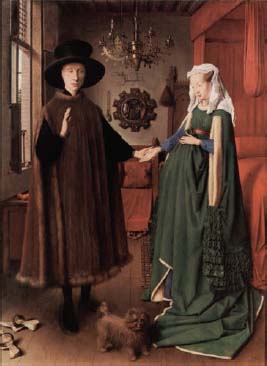The Early Modern World, C. 1300–1600Northern European Renaissance |
How did Jan van Eyck achieve such incredible detail in his work? |
The work of Jan van Eyck is known for its incredible detail and realism. Like other artists of Northern Europe, van Eyck used oil paints. Oil paints take a long time to dry, allowing artists time to work slowly and blend colors. Northern artists like van Eyck built up layers of oil paint by applying many thin glazes. Compared to the egg-based tempera paints used in Italy, oil paints can achieve much richer hues. Paintbrushes made for painting detail were important—some brushes were so thin that they were made of a single hair! Jan van Eyck is thought to be one of the first Renaissance artists to extensively use optic technology, such as convex mirrors and lenses, to help achieve a high level of detail in his work.

The enigmatic Arnolfini Portrait (1434) was painted by Northern Renaissance master Jan van Eyck. This marriage portrait is filled with symbolic images and emphasizes the material quality of the objects in the scene.
